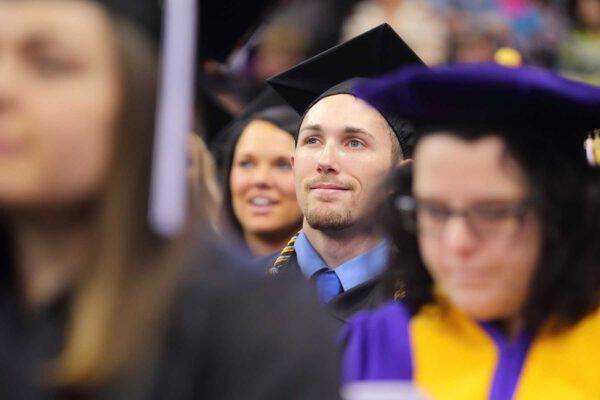By Robin Zape-tah-hol-ah Minthorn
This post is part of the series Beyond the Margins: Meeting the Needs of Underserved Students.
While the number of Native American students on college campuses has increased over the last 50 years, this broad trend—while good news—presents a fragmented understanding of these students’ participation in and access to higher education.
What we know is that, in 2016 the total college enrollment rate for American Indian/Alaska Native 18- to 24-year-olds (19 percent) was not measurably different from their 2000 rate. And the six-year graduation rate for first-time, full-time American Indian/Alaska Native undergraduates who began their pursuit of a bachelor’s degree at a four-year, degree-granting institution in fall 2011 was 39 percent, the lowest of all racial and ethnic groups. We also know that success for Native American students requires that higher education be responsive to the unique values, needs, and perspective each student brings to campus.
This post aims to move beyond the asterisk and situate Native American students* not in response to national data or the lack thereof, but as individuals on our campuses. How are they represented? How are their stories being told? Are they able to tell their own stories? Do institutions understand who they are, what they think, and what they need?
Unique perspectives and identities of indigenous students
One pervasive stereotype and misconception of Native American students is that we are all the same. This is not the case. We are not homogenous, and each of our tribal nations have complex stories and places of being. That means Native student stories are complex and need to be honored for what they are and who they represent. Among these unique identities:
Tribal citizen. Many Native American students come to campus with dual citizenship, meaning they are a citizen of their tribal nation. Just as some Americans are patriotic and have an affinity for the United States, Indigenous students have a close connection and responsibility to their tribal nation.
It is important to note that the blood quantum and citizenship process has excluded many other Native American students due to the limitations of the person not fulfilling the current standards of blood quantum in place for their tribal nations and/or identifying with multiple identities and racialized groups.
Question: Does data collection on our campuses honor and acknowledge tribal citizenship on campus?
Land, language, and culture. Many Native American students have a strong connection to land, language, and culture. While some have been connected to their own tribal culture since birth, many of our Native American students have grown up or were born in urban areas where their connections have been fragmented or inconsistent.
Question: How does the current curriculum integrate and honor Indigenous culture and language? How does your position on campus allow you to advocate reconciliation for Indigenous peoples, particularly tribal communities whose land is occupied by institutions?
Intertribal and multi-racial. Most Native American students are either intertribal or multi-racial. Intertribal means they hold citizenship with one tribe but are descendants of multiple tribes. However, some Native American students might identify as multi-racial and have to balance, or feel like they are required to balance, all of their identities.
Question: How are we creating safe and culturally specific spaces for Native American students on campus?
First-generation college students. Despite an increasing amount of Native American college students that are second- and third-generation, many do not know how to navigate higher education, especially when they are one of the least represented groups of students in higher education.
Question: What guides and sources of support are provided specifically for Native American students on your campus to help them navigate from entrance to completion?
Indigenizing high-impact practices
Many faculty, professional staff, and administrators are interested in high-impact practices for the general student body. Some high-impact practices such as first–year seminars and experiences, undergraduate research, diversity/global learning, or capstone courses and projects need to align with the culture and values of certain sub-populations on campus. If we are to begin to understand how to support our Native students, we need to understand their lived experiences and realities.
Appreciate the influence of culture on college attendance. It is important for higher education administrators, student affairs professionals, and faculty to know that it is our cultural values that guide and motivate Native American students to pursue higher education, while keeping in mind that not all of us hold the same tribal and cultural values (i.e., cultural values of community, responsibility, fishing/hunting, matrilineal/patrilineal inheritance, grieving practices, birthing practices, etc.).
Question: How does your campus provide space for Native American students to see their cultural values, or acceptance of them, in the retention efforts and support resources provided on campus?
Honor complex stories and backgrounds. Making connections with Native American students’ lived realities and making their experiences meaningful is of utmost importance as Native students make sense of their place on campus. In supporting meaning-making, institutions must recognize the unique experiences of Native American students individually and not assume that all have the same lived experience.
Question: How does your campus provide opportunities for students to make meaning of their experiences on campus and the higher education degree they are pursuing? How are administrators, professional staff, and faculty trained to provide opportunities to get to know students without inserting preconceived notions and biases against Native American people?
Accommodate the reality to balance school, home, and cultural obligations. Higher education institutions need to make sure they are acknowledging the multiple roles and responsibilities that Native American students have within their families and communities. This means making sure there are resources accessible to Native American students when there is an emergency that calls for them to return home and acknowledging the ceremonial timeline that exists within each of their respective communities.
Question: What are the current policies and resources available for students on campus when they have an emergency situation or have lost a loved one?
Foundational praxis for indigenous people and presence in higher education
Aside from Indigenizing high impact practices, below are recommendations for what should be foundational praxis for institutions to support their Indigenous students, faculty, and staff.
- Examine the narrative of Indigenous peoples in the institution’s history
- Participate in Indigenous land acknowledgment(s)
- Invest in a tribal liaison
- Establish memorandums of understanding (MOU) with Native nations
- Provide a Native student support center and staff
- Create or maintain a Native student gathering space
- Build a Native American faculty presence
- Establish or strengthen the Native American studies department
- Conduct Native American campus climate studies (for students, faculty, and staff)
- Increase Native American administrators at the upper levels of administration
- Embed Native Americans in the board of regents
- Establish a Native American council
These recommendations are for all institutions of higher education to consider regardless of the size of their Native American student population. As equity and inclusion initiatives permeate our campuses, we must ask where our Native American students are in the services, representation, and work. They are more than an asterisk; they are their ancestors’ dreams and prayers coming into being.
* Native American, Native, and Indigenous are used interchangeably in this post.
If you have any questions or comments about this blog post, please contact us.

